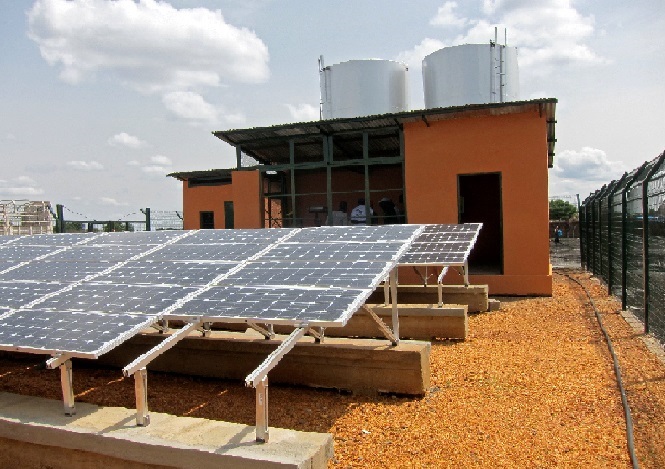Partnerships are being developed to accelerate assessment of the use of renewable energy in key fuel consuming delegations, energy sensors are being deployed and an ‘Internet of Things’ (IoT) energy monitoring platform is being developed to allow the ICRC to better manage its energy consumption at its premises.
In operations, too, the ICRC is striving to grow its climate-sensitive programming in response to the increasing numbers of people around the world who are feeling the damaging impacts of climate change. An ICRC energy training center is being set-up in Nairobi, Kenya, to increase ICRC staff capacity to deal with growing energy needs, and new financing models (NFMs) are being explored to fund an ICRC energy transition and support partnership building.
Together with UNITAR and Energypedia, the ICRC is hosting the sustainable energy webinar series and contributing to building a network of practitioners in the field of power supply for humanitarian operations sharing best practices, reference case studies and publications.
With over 2,500 premises spread across 500 sites in 115 countries, the ICRC’s worldwide reach necessitates a large and varied energy consumption, but some activities and operations use more than others. An analysis carried out by Volta Capital, consultants working with the ICRC NFM Unit, found that just a dozen sites in seven countries—all places where grid electricity is unreliable or non-existent—account for about half the ICRC’s diesel generator use.
Greening the ICRC
Switching to solar in these locations would be costly upfront, but Volta estimated it could represent a huge saving in the longer run, as Energy Challenge lead Dikolela Kalubi explains: “If we invest 10 million Swiss francs now, we can save up to 50 million Swiss francs over 20 years.” This can free up much needed resources for humanitarian action.
It would also mean current annual carbon dioxide emissions can be expected to be reduced by a quarter in those key sites. “It’s mainly about installation of solar panels, but we keep in mind that the greenest, the cheapest energy is the one we don’t use,” he says, of the need for behavioral, as well as technological, change. “We have a business case for the use of solar energy, the focus now is to make it happen.”
Greening the ICRC’s premises with solar panels is important—and will help the organization to meet its ambition of reducing carbon emissions from its diesel generators by more than 25% over five years—but it is only a first step towards thinking of sustainable electricity provision as a core service for people affected by conflict. “At the moment we rely on power from the grid or generators, but in operations we are also developing more and more projects using renewable energy,” says Kalubi.
The new energy training hub in Nairobi will help provide ICRC staff with the skills to supervise renewable energy projects in the field. “We are trying to increase the skills and capacity of our engineers to implement projects using renewable energy as they work to meet our growing energy needs,” says Kalubi. Where ICRC can use solar at its own facilities, it extends the possibility to use renewable energies within its operations such as in hospitals or schools.
Funding the transition
Environment and climate change advisor, Kathrine Vad, is exploring whether “ICRC assistance activities could be eligible for carbon credits”, for example, the distribution of clean cookstoves and solar lamps, or the installation of solar water heaters. The resulting credits could be used to offset the ICRC’s own emissions or sell on the carbon market, generating additional funds for the energy transition.
Vad has also been crunching the data to quantify the ICRC’s carbon footprint and later this year, the ICRC is expected to adopt a formal greenhouse gas reduction target.
One enabler identified in the Energy Challenge is how to better support the transition with funding of dedicated expertise, upfront capital or guarantees for private sector partnerships. Innovative finance advisor, Catherine Howell, suggests a dedicated fund might be an answer to covering the long-term costs of the coming transformation.
“Our research shows opportunities to diversify funding,” she says, mentioning new government funding reserved for sustainability investments, philanthropists and foundations, private finance, among others. Establishing a new fund specifically for the energy transition would also ensure that existing donor money intended for humanitarian responses is spent on humanitarian responses—not solar panels—while also freeing the multi-year energy transition project from the uncertainty of annual budgets.
The fund could help attract private sector partners by mitigating their risk, for example by guaranteeing a power-purchase agreement (PPA), and could become self-sustaining by capturing the projected savings on energy costs or applying an internal levy on fuel consumption. Whatever shape it takes, Howell envisages a “multi-year, results-based energy transition fund which, in the short term, will support premises, but will be structured so it can grow to support energy needs in our operations.”
Cross-cutting change
Understanding energy as transversal—something that is relevant to everyone, cutting across departments, divisions, organizations and sectors—will help drive behavior change, something that Kalubi predicts will be as fundamental to the ICRC’s energy transition as solar panels or new financing models.
“When we talk about energy transition it’s for sure related to technology, but it’s also about processes, skills and behavior,” he says. “We have to foster energy literacy within our staff.”

